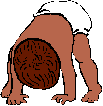
Some roll over and over.
Some go straight on to their feet and walk.
However they move, mobility is the key to exploring and learning more about the world.

 |
Babies move in their own
characteristic way. Some creep on their tummies. Some crawl. Some bottom
shuffle. Some bear walk. Some roll over and over. Some go straight on to their feet and walk. However they move, mobility is the key to exploring and learning more about the world. |
 |
The older baby is an explorer.
Babies learn about the world through the senses and as they move. Once a baby
can sit, two hands are free to hold and investigate objects from every angle.
Once babies are mobile they can explore exciting places for themselves. It is
often trying to reach a desired object that motivates baby to move. At first it
is frustrating but from 9 months of age baby can move around the floor.
At around 6 months the baby
can sit up with support. Strength and balance develop so baby can sit securely
and use both hands to manipulate objects. At first baby uses a palmar grasp with
the whole hand to grasp toys. Babies enjoy investigating everyday objects. If
an object is light in weight, safe and chewable, this is excellent learning. A
baby takes objects to the mouth. The baby's mouth is sensitive and chewing can
confirm if the object is hard or soft. It takes time to learn to use fingertips
to explore different textures. Meanwhile the mouth is very useful.
The next stage is passing
objects from hand to hand. The baby looks carefully at objects and turns them
round to investigate thoroughly. Learning to use the hands and eyes in co-ordination
helps the baby learn the nature of objects. The shape, colour, size and texture.
Although, he or she has no understanding of colour and texture baby can experience
what it feels and looks like. All these impressions help the baby to learn about
the world. Physical and cognitive development work together. Sensory objects that
are brightly coloured, make a noise, have different textures and move are attractive
to babies.
It is fun manipulating two
objects, one in each hand and trying to bang them together. Then baby points to
small objects and pokes them with the index finger. The pincer grip develops and
by the time baby is 1 year old it is easy to pick up tiny objects using the thumb
and index finger. Nothing is safe from a baby's busy fingers and adults need to
be vigilant to prevent accidents because babies can choke on small objects.
Learning to let go is harder
than picking up an object, but it all comes together at about 8 months of age.
The baby learns to voluntarily let go of objects and also learns an important
feature of the world. Things and people do not disappear just because you cannot
see them. Piaget calls this "object permanence." When something drops out of sight
a young baby does not look for it. Gradually, babies realise things do not disappear
forever and will look for a dropped toy. Throwing things out of a highchair is
great fun and teaches baby physics. Baby does not know about gravity, but sees
the effect when things that are dropped fall down.
Using the hands is an important
skill for independent life. From 8 to 9 months of age babies enjoy finger foods
and given the opportunity can feed themselves. Bread, bananas, pasta, fingers
of vegetables and sausages go down well. Using a spoon is more tricky and messier
but babies like to try. By the time baby is 1 year old, he or she is skilled in
picking up objects with both hands and with fingers, skilled in exploring objects
by looking, banging, shaking and poking and can eat finger foods.
The social friendly baby
becomes nervous of strangers. This is because baby is learning to recognise the
family. Baby thrives on interaction and a new favourite game is Peekaboo. It is
fun when baby knows their caregiver is still there and the surprise makes baby
laugh. Babies enjoy rhymes and action songs especially clapping hands and waving.
Language develops. The baby understands and can respond to simple requests e.g.
clap hands. Baby shouts and points to gain interesting things. The tuneful babbling
sounds like a conversation as baby immitates sounds. First words are names of
people and things e.g. Dada, Mama. By 1 year old, the baby knows his or her own
name. The baby is mobile, manipulates objects with both hands, knows the family
and their own name, understands language and can make their own wishes known.
Learning more about the world advances as the baby becomes more independent and
mobile.

The mobile explorer:
Please come and see each separate page for profiles of child development.
A NEWBORN BABY
come and see A YOUNG SOCIABLE BABY
come and see A MOBILE BABY EXPLORER
come and see AN INDEPENDENT TODDLER
come and see A NURSERY SCHOOL CHILD
come and see AN INFANT SCHOOL PUPIL
come and see PROFILES INTRODUCTION
come and see

Visitors to this page since 17th Nov 2004 . Maintained by Road Ahead